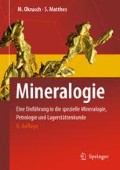Zusammenfassung
In der Klasse der Oxide bildet der Sauerstoff Verbindungen mit ein, zwei oder mehreren Metallen. In ihren Kristallstrukturen liegen im Unterschied zu den Sulfiden jeweils annähernd Ionenbindungen mit teilweise Übergängen zur homöopolaren Bindung vor. Durch Unterschiede in ihrem Metall-Sauerstoff-Verhältnis M : O zeichnen sich mehrere Verbindungstypen ab, wie M2O, MO, M2O3 und MO2. Neben diesen ein fachen Oxiden gibt es kompliziertere oxidische Verbindungen mit zwei oder mehreren Metallionen wie X[4]Y2 [6]O4, die als Spinelltyp bezeichnet werden. Im gewöhnlichen Spinell besetzt Mg2+ die tetraedrisch koordinierte Position von X und Al3+ die oktaedrisch koordinierte Position von Y, im Magnetit (Fe3O4) nehmen (Fe2+, Fe3+) die Position von X und (Fe3+, Fe2+) die Position von Y ein. Die wichtigsten Vertreter der Oxide sind in Tabelle 5.1 aufgeführt.
†Deceased
Access this chapter
Tax calculation will be finalised at checkout
Purchases are for personal use only
Preview
Unable to display preview. Download preview PDF.
Weiterführende Literatur
Deer WA, Howie RA, Zussman J (1962) Rock-forming minerals. Vol 5: Non-silicates. Longmans, London
Grew ES (ed) (2002) Beryllium – mineralogy, petrology, geo chemistry. Rev Mineral Geochem 50
Lindsley DH (ed) (1991) Oxide minerals: Petrologic and magnetic significance. Rev Mineral 25
Macfarlane AM, Miller M (2007) Nuclear energy and uranium resources. Elements 3:185–192
Pasero M (2005) A short outline of tunnel oxides. Rev Mineral Geochem 57:291–305
Rumble III D (ed) (1976) Oxide minerals. Rev Mineral 3
Zitierte Literatur
Lindsley DL (1976) The crystal chemistry and structure of oxide minerals as exemplified by the Fe-Ti oxides. In Rumble III D, ed (1976) Oxide minerals. Rev Mineral 3:L1–L88
Meshik AP (2006) Natürliche Kernreaktoren. Spektrum der Wissenschaft, Juni 2006, S 85–90
Ringwood AE, Kesson SE, Ware NG, Hibberson WO, Major A (1979) The SYNROC process: A geochemical approach to nuclear waste immobilization. Geochem J 13:141–165
Author information
Authors and Affiliations
Rights and permissions
Copyright information
© 2010 Springer-Verlag Berlin Heidelberg
About this chapter
Cite this chapter
Okrusch, M., Matthes †, S. (2010). Oxide und Hydroxide. In: Mineralogie. Springer-Lehrbuch. Springer, Berlin, Heidelberg. https://doi.org/10.1007/978-3-540-78201-8_5
Download citation
DOI: https://doi.org/10.1007/978-3-540-78201-8_5
Published:
Publisher Name: Springer, Berlin, Heidelberg
Print ISBN: 978-3-540-78200-1
Online ISBN: 978-3-540-78201-8
eBook Packages: Life Science and Basic Disciplines (German Language)

